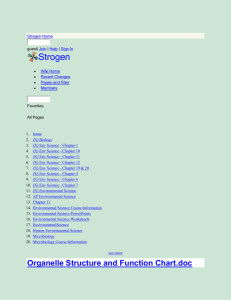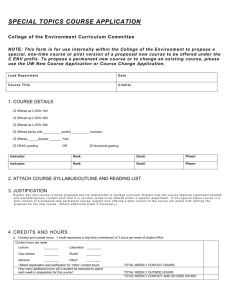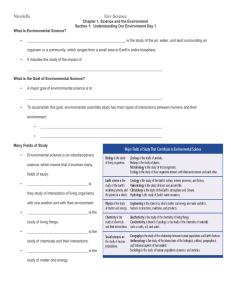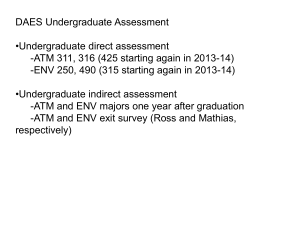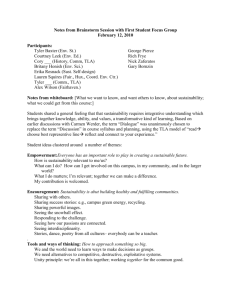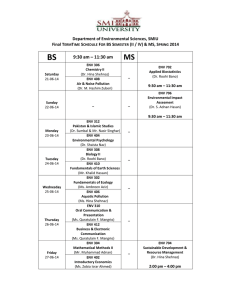Capacity of a bosonic memory channel with Gauss- Markov noise Please share
advertisement
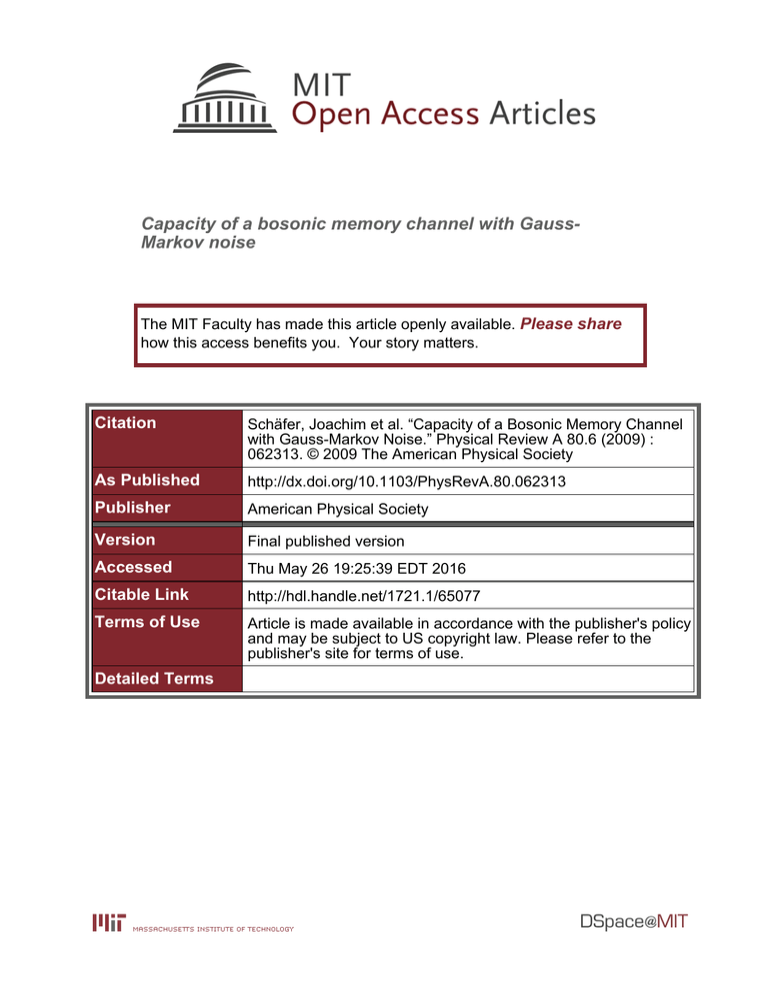
Capacity of a bosonic memory channel with GaussMarkov noise The MIT Faculty has made this article openly available. Please share how this access benefits you. Your story matters. Citation Schäfer, Joachim et al. “Capacity of a Bosonic Memory Channel with Gauss-Markov Noise.” Physical Review A 80.6 (2009) : 062313. © 2009 The American Physical Society As Published http://dx.doi.org/10.1103/PhysRevA.80.062313 Publisher American Physical Society Version Final published version Accessed Thu May 26 19:25:39 EDT 2016 Citable Link http://hdl.handle.net/1721.1/65077 Terms of Use Article is made available in accordance with the publisher's policy and may be subject to US copyright law. Please refer to the publisher's site for terms of use. Detailed Terms PHYSICAL REVIEW A 80, 062313 共2009兲 Capacity of a bosonic memory channel with Gauss-Markov noise Joachim Schäfer, David Daems, and Evgueni Karpov QuIC, Ecole Polytechnique, Université Libre de Bruxelles, CP 165, 1050 Brussels, Belgium Nicolas J. Cerf QuIC, Ecole Polytechnique, Université Libre de Bruxelles, CP 165, 1050 Brussels, Belgium and Research Laboratory of Electronics, Massachusetts Institute of Technology, Cambridge, Massachusetts 02139, USA 共Received 8 July 2009; published 7 December 2009兲 We address the classical capacity of a quantum bosonic memory channel with additive noise, subject to an input energy constraint. The memory is modeled by correlated noise emerging from a Gauss-Markov process. Under reasonable assumptions, we show that the optimal modulation results from a “quantum water-filling” solution above a certain input energy threshold, similar to the optimal modulation for parallel classical Gaussian channels. We also derive analytically the optimal multimode input state above this threshold, which enables us to compute the capacity of this memory channel in the limit of an infinite number of modes. The method can also be applied to a more general noise environment which is constructed by a stationary Gauss process. The extension of our results to the case of broadband bosonic channels with colored Gaussian noise should also be straightforward. DOI: 10.1103/PhysRevA.80.062313 PACS number共s兲: 03.67.Hk, 89.70.Kn, 03.67.Bg, 03.67.Mn I. INTRODUCTION The growing importance of quantum communication motivates a strong research activity on quantum channels. The classical capacity of a communication channel is defined as the supremum of the rate of classical information that can be transmitted via the channel. An important question for quantum channels is whether or not entangling the channel inputs may improve the transmission rate. The additivity conjecture proven to be true for some memoryless quantum channels 共see 关1兴 and references herein兲 implies that entanglement does not improve the transmission rate. Although this conjecture was disproved recently for another class of channels in Ref. 关2兴, it remains an interesting question in itself to determine whether entanglement helps or not to achieve the capacity. In particular, it was shown for some channels with memory, where the environment exhibits a correlation between subsequent uses of the channel, that the transmission rate can be increased by using entangled input states. In the case of a quantum memory channel with discrete alphabet, the first studies of the classical capacity considered a depolarizing channel 关3兴 and a quasiclassical depolarizing channel 关4兴 and showed the existence of a threshold on the degree of memory above which entangled signals improve the transmission rate with respect to product states. Further studies 关5,6兴 on a qubit channel with finite memory derived bounds on the classical and quantum capacities. In Ref. 关7兴, the classical and quantum capacities were discussed in a general framework, where furthermore, a malicious third party may have control of the initializing memory. The case of general Pauli channels with memory was studied explicitly in Ref. 关8兴, where it was shown that the optimal states are either product states or Bell states separated by a memory threshold. The behavior of channels with correlated error was connected to quantum phase transitions in many-body systems in Ref. 关9兴. The quantum capacity of a dephasing channel was computed in Ref. 关10兴, where an enhancement of the capacity with increasing memory was proven. For 1050-2947/2009/80共6兲/062313共11兲 higher dimensions, it has been shown that the capacity of qudit channels exhibits the same threshold phenomenon as Pauli qubit channels 关11,12兴. For a quantum channel with continuous alphabet, it was first shown for an additive bosonic channel and a lossy bosonic channel, respectively 关13,14兴, that in the presence of a memory, some degree of entanglement between the input states is necessary to achieve the capacity, which is in contrast to the behavior reported for discrete quantum channels. Indeed, the optimal input states correspond to EinsteinPodolski-Rosen 共EPR兲 states with finite squeezing which increases with the degree of memory, in contrary to either maximally or nonentangled states in the discrete case. A lossy bosonic channel with correlated environment and an input energy constraint has been studied 关15–17兴. Lower and upper bounds for the classical capacity were derived in Ref. 关14兴 and the capacity was calculated in Refs. 关15–17兴. In this paper, we discuss a bosonic memory channel with additive noise modeled by a Gauss-Markov process. We present an extension of the model of Ref. 关13兴, where two uses of a bosonic additive channel with correlated noise were treated, to the case of n channel uses with Gauss-Markov noise. We determine the classical capacity of the channel in the asymptotic limit. In Sec. II, we recall the definition of the classical capacity of quantum channels and specify the model of the channel under an input energy constraint. Section III is devoted to the treatment of a monomodal channel with phase-dependent noise where the quantum water-filling emerges as optimal solution. In Sec. IV, we introduce the method for finding the capacity and apply it to the Gauss-Markov memory. Under reasonable assumptions, we determine the optimal solution as a global water-filling solution and obtain the classical capacity of the channel. Section V treats the capacity in several limiting cases: the limit of full correlations, the classical limit, the case of a modified thermal noise, and the transition from finite to infinite uses. 062313-1 ©2009 The American Physical Society PHYSICAL REVIEW A 80, 062313 共2009兲 SCHÄFER et al. II. BOSONIC ADDITIVE CHANNEL In order to send classical information through a quantum channel, one chooses an alphabet and associates its letters to quantum states in i , where index i labels the letters of the alphabet. The input states sent through the channel interact with the environment and thus are modified at the output. The action of the channel T is a completely positive, tracepreserving map acting on the input states in i , in out i = T关i 兴. Let us now assume T共n兲 to be a n-mode bosonic additive channel with memory. In the following, the number of modes of this channel corresponds to the number of monomodal channel uses. Each mode j is associated with the annihilation and creation operators a j , a†j , respectively, or equivalently to the quadrature operators q j = 共a j + a†j 兲 / 冑2 , p j = i共a j − a†j 兲 / 冑2 which obey the canonical commutation relation 关qi , p j兴 = i␦ij, where ␦ij denotes the Kronecker delta. By ordering the quadratures in a column vector 共1兲 In the messages, each letter appears with a certain probability pi so that the overall modulated input state is described as a mixture in = 兺 piin i . R = 共q1, . . . ,qn ;p1, . . . ,pn兲T , we can define the displacement vector m and covariance matrix ␥ of a n-mode state as m = Tr关R兴 共2兲 1 ␥ = Tr关共R − m兲共R − m兲T兴 − J, 2 i By linearity of T, Eq. 共1兲 determines as well the action of the channel on the overall modulated input 共2兲, that is, ¯ ⬅ 兺 piout i = T关 兴, in where 共3兲 J=i i where we will refer to ¯ as the overall modulated output. In order for the overall modulated input to be physical, it has to obey the energy constraint 兺i pi Tr共ini a†a兲 ⱕ n̄, 共4兲 where n̄ is the maximum mean photon number per use of the channel and will be referred to as “input energy” in the following. The classical capacity C共T兲 of the channel T represents the supremum on the amount of classical bits which can be transmitted per invocation of the channel via quantum states in the limit of an infinite number of channel uses. This quantity can be calculated with the help of the so-called one-shot capacity, defined as in 关18兴, C1共T兲 = sup , in i ,pi 共5兲 冉兺 i 冊 in piT关in i 兴 − 兺 piS共T关i 兴兲, W␣in共R兲 = 共6兲 i with the von Neumann entropy S共兲 = −Tr共 log 兲 where log denotes the logarithm to base 2. The supremum in Eq. 共5兲 is taken over all ensembles of 兵pi , in i 其 of probability distributions pi and pure input “letter” states in i 关18兴. The term “one-shot” means that only one invocation of T is needed to calculate Eq. 共5兲. Using this quantity, the capacity C共T兲 defined as above may be evaluated in the following way. A number n of consecutive uses of the channel T can be equivalently considered as one parallel n-mode channel T共n兲, which is used only one time. Then the capacity C共T兲 is evaluated in the limit 1 C共T兲 = lim C1共T共n兲兲. n→⬁ n 共7兲 共9兲 冉 冊 0 1 共10兲 −1 0 is the symplectic or commutation matrix with the n ⫻ n identity matrix 1. In this paper, we focus on Gaussian states, which are fully characterized by m and ␥. Furthermore, without loss of generality, we set the displacement of overall modulated states and the means of classical Gaussian distributions to zero because displacements do not change the entropy. For the bosonic channel, the encoding of classical information is made by using a continuous alphabet, where the previous discrete letter with index i is replaced by the real and imaginary parts of a complex number ␣. A message of length n is therefore encoded in a 2n real column vector ␣ = 共Re兵␣1其 , Re兵␣2其 , . . . , Re兵␣n其 , Im兵␣1其 , . . . , Im兵␣n其兲T. Physically, this encoding corresponds to a displacement of the n-partite Gaussian input state in the phase space by ␣ and is denoted by ␣in. The Wigner function of ␣in reads where the Holevo quantity reads =S 共8兲 −1 共R − 冑2␣兲兴 exp关− 21 共R − 冑2␣兲†␥in 共2兲n冑det共␥in兲 . 共11兲 Throughout this work, we use the recently proven conjecture that a coherent state minimizes the entropy of a monomodal Gaussian thermal channel 关19兴. As we show in Secs. III and IV, we only need the extension of this proof to the case of a monomodal Gaussian channel with anisotropic noise to justify that the optimal n-partite input state is Gaussian. As a result, we only consider Gaussian distributions of the letters in the messages so that the overall modulated input state sent through the channel is a mixture in = 兰d2n␣ f共␣兲␣in, where d2n␣ = dRe兵␣1其dIm兵␣1其 . . . dRe兵␣n其dIm兵␣n其 with Gaussian distribution f共␣兲 = −1 ␣兴 exp关− ␣T␥mod n冑det共␥mod兲 , 共12兲 centered at zero and characterized by the modulation covariance matrix ␥mod. 062313-2 PHYSICAL REVIEW A 80, 062313 共2009兲 CAPACITY OF A BOSONIC MEMORY CHANNEL WITH… As we are no longer dealing with probability distributions pi but with probability densities f共␣兲, the summations in the formulae above are replaced by proper integrations. The action of T共n兲 on an input state carrying a message ␣ reads as in 关13兴 T 共n兲 关␣in兴 = = ␣out 冕 d  f env共兲D共n兲 丢 ¯ 2n  = 共Re兵1其, . . . ,Re兵n其,Im兵1其, . . . ,Im兵n其兲T , and the displacement operator D共 j兲 = exp共 jâ†j − ⴱj â j兲. The displacement is applied according to the Gaussian distribution of the environment 冑det共␥env兲 n , ␥out = ␥in + ␥env , ␥in,␥mod 共15兲 ␥env = 共18兲 共19兲 冉 冊 共q兲 0 ␥env 共p兲 , 0 ␥env 共q兲 共p兲 ␥env ⫽ ␥env . 共20兲 冉 共qp兲 ␥共q兲 ␥in in ␥共qp兲 ␥共p兲 in in 冊 , ␥mod = 冉 共q兲 共qp兲 ␥mod ␥mod 共qp兲 共p兲 ␥mod ␥mod 冊 . 共21兲 共16兲 We now determine the optimal ␥in , ␥mod by solving equation Eq. 共16兲 with energy constraint 共19兲 and the requirement to have a pure input, i.e., 共17兲 1 det ␥in = . 4 In the case of a Gaussian state , the von Neumann entropy can be expressed in terms of the symplectic eigenvalues j of its covariance matrix L=g 冎 The optimal solution of a channel with such a noise has not yet been fully studied. In Ref. 关20兴, the capacity of a multiaccess channel with such a noise was studied but the optimal input and modulation were not discussed in detail. It was shown 关19兴 for a monomodal thermal channel that a coherent input state which is modulated according to a Gaussian modulation achieves the capacity. We conjecture that this proof can be extended to the case of the noise given by Eq. 共20兲, i.e., that a Gaussian input state and a Gaussian modulation remain optimal. The general input and modulation covariance matrices read ␥in = with the Holevo quantity which then reduces to n = S共兲 − S共␣out兲. x = 0. First we study the monomodal channel T, where the input state undergoes a phase-dependent noise with covariance matrix The one-shot capacity of such a system is C1共T共n兲兲 = sup n , 0, III. MONOMODAL PHASE-DEPENDENT CHANNEL 共14兲 with 共classical兲 covariance matrix ␥env. If this matrix is not diagonal, then the environment introduces correlations between the successive uses of the channel. These correlations model the memory of the channel. Since we centered the distributions of the environment and modulation as well as the Wigner function of the input state around zero, the covariance matrices of the state carrying the message ␣ at the output of the channel ␣out and of the overall modulated output state read, respectively, ␥ = ␥out + ␥mod . 共x + 1兲log共x + 1兲 − x log x, x ⬎ 0 We remark that in Eqs. 共17兲–共19兲, the quantities depend only on the covariance matrices and not on a particular message ␣. Therefore, we can fully discuss the action of the channel solely in terms of covariance matrices. d2n = d Re兵1其d Im兵1其 . . . d Re兵n其d Im兵n其, −1 兴 exp关− T␥env 再 冊 1 1 关Tr共␥in兲 + Tr共␥mod兲兴 − = n̄. 2 2n 共13兲 with f env共兲 = g共x兲 = j 1 , 2 The energy 共or mean photon number兲 constraint 共4兲 is given by in 丢 D共1兲␣ D†共1兲 ¯ 丢 D†共n兲, 丢 冉 S共兲 = 兺 g 兩 j兩 − 共22兲 With these constraints, we can write out the total Lagrangian of the system, i.e., 冉冑 共p兲 共p兲 共qp兲 共qp兲 2 共q兲 共q兲 共p兲 共␥共q兲 in + ␥env + ␥mod兲共␥in + ␥env + ␥mod兲 − 共␥in + ␥mod兲 − 共p兲 共q兲 共p兲 共q兲 共p兲 − 共␥共q兲 in + ␥mod + ␥in + ␥mod兲 − 共␥in ␥in 兲, 冊 冉冑 1 −g 2 共qp兲 2 共q兲 共p兲 共p兲 共␥共q兲 in + ␥env兲共␥in + ␥env兲 − 共␥in 兲 − 1 2 冊 共23兲 062313-3 PHYSICAL REVIEW A 80, 062313 共2009兲 SCHÄFER et al. 共q兲 共q兲 ␥mod = − ␥out , µ γ(q) 共p兲 共p兲 ␥mod = − ␥out , Optimal eigenvalues mod 共q,p兲 共q,p兲 = ␥共q,p兲 where ␥out in + ␥env and where the quantum waterfilling level ⬅ ¯␥共p兲 = ¯␥共q兲 is determined by Eq. 共26兲. Equations 共28兲 and 共29兲 are depicted in Fig. 1. Note that both modulation eigenvalues 共29兲 have to be nonnegative to be physical. This condition together with Eq. 共28兲 result in the threshold on the input energy γ(p) mod γ(q) in n̄ ⱖ n̄thr = γ(p) in γ(q) env 共29兲 1 2 冉冑 共q兲 共p兲 max兵␥env , ␥env 其 共q兲 共p兲 min兵␥env , ␥env 其 冊 共q兲 共p兲 + 兩␥env − ␥env 兩−1 , 共30兲 γ(p) env q p Quadratures FIG. 1. 共Color online兲 Quantum water-filling solution for the monomodal channel. Optimal eigenvalues for both quadratures. below which the obtained solutions do not hold. Knowing all optimal eigenvalues of the system, we can easily determine the one-shot capacity defined by Eq. 共16兲, 冉 C1 = g n̄ + where and are Lagrangian multipliers. We arrive at a system of eight equations where the solution reads as follows. First, we find that 共qp兲 ␥in = 共qp兲 ␥mod = 共24兲 0, i.e., all three covariance matrices are diagonal in the same basis. Second, we obtain 共q兲 共q兲 共q兲 共p兲 共p兲 ␥in + ␥env + ␥mod = ␥共p兲 in + ␥env + ␥mod , 共25兲 which can be regarded as a “quantum water-filling” 关27兴 solution and implies that the optimal output state ␥ is a thermal state 共see Fig. 1兲. This repartition of input energy for the preparation of the quantum state and the classical modulation generalizes the situation of parallel classical channels with a joint energy constraint. Here, we have two channels: one for the q quadrature and one for the p quadrature. The eigenvalues of the covariance matrix of the modulated output state read ¯␥共q兲 = ¯␥共p兲 = n̄ + 共q兲 共p兲 ␥env + ␥env 1 + , 2 2 共q兲 ␥共q兲 ␥env in 共p兲 = 共p兲 . ␥in ␥env 共27兲 Thus, the squeezing at the input has to match exactly the phase dependence of the noise. Since all matrices are diagonal, we conclude that the vari共p兲 共q兲 共p兲 ables ␥共q兲 in , ␥in , ␥mod , ␥mod are the eigenvalues of ␥in , ␥mod. Using the condition that the input has to be pure 共22兲, we conclude from Eq. 共27兲 that ␥共q兲 in = 1 2 冑 共q兲 ␥env 共p兲 , ␥env ␥共p兲 in = 1 2 冑 共p兲 ␥env 共q兲 . ␥env Then, the modulation eigenvalues simply read 共28兲 n̄ ⱖ n̄thr . 共31兲 One notices that in the first term the algebraic mean of the 共q兲 共p兲 + ␥env 兲 / 2 and in the second term the geometric noise 共␥env 共q兲 共p兲 −1/2 appear. Comparing C1 to the definition of mean 关␥env␥env兴 the Holevo quantity 共6兲, one can say that the first term corresponds to the entropy of a thermal state with a mean photon number identical to the mean energy of the system and, roughly speaking, the second term corresponds to the average of the entropies of two thermal states with means 共q兲 共p兲 共q兲 共p兲 ␥env , ␥env . In the case ␥env = ␥env = N, we recover the capacity of a monomodal thermal channel C = g共n̄ + N兲 − g共N兲. IV. GAUSS-MARKOV CHANNEL Now we proceed with the central part of this paper: the treatment of the multimode channel as introduced in Eq. 共13兲 with a Gauss-Markov noise. 共26兲 which simply reflects the total energy of the system. Third, we obtain the optimal degree of squeezing of the input state 冊 共q兲 共p兲 ␥env + ␥env 共q兲 共p兲 − g共冑␥env ␥env兲 . 2 A. Noise model Assume a Gaussian-distributed real random vector Z that is generated by a Markov process Zi = Zi−1 + Wi, 0 ⱕ ⬍ 1, 共32兲 where Wi are Gaussian distributed and identically and independently distributed. We set without loss of generality the expectation values E共Zi兲 = E共Wi兲 = 0. We request in addition that the variance Var共Zi兲 = N, which leads to Var共Wi兲 = 共1 − 2兲N. Then we conclude that the matrix elements of the covariance matrix M for the Gauss-Markov process 共32兲 read M ij共兲 ⬅ Cov共Zi,Z j兲 = N兩i−j兩, 0 ⱕ ⬍ 1, 共33兲 where N 苸 R denotes the variance and is the nearestneighbor correlation. Equation 共33兲 is a symmetric Toeplitz matrix which is completely defined by its diagonal elements 共M兲 兩k兩 t共M兲 k = N = t−k 共see Appendix A兲. 062313-4 PHYSICAL REVIEW A 80, 062313 共2009兲 CAPACITY OF A BOSONIC MEMORY CHANNEL WITH… In the following, we treat the channel given by Eq. 共13兲 with a classical noise covariance matrix ␥env = 冉 M共兲 0 0 M共− 兲 冊 共34兲 , where M共兲 reads as in Eq. 共33兲. In other words, the noise of the q 共p兲 quadratures results from a Gauss-Markov process with 共anti-兲 correlated nearest neighbors. In order to determine the capacity of the memory channel 共13兲, one needs to find the optimal input and modulation covariance matrices which obey the energy constraint 共19兲. One can treat equally this problem in the basis where the channel becomes memoryless provided that one can rotate the noise covariance matrix by a passive symplectic transformation into the basis where it is diagonal. This is possible because a passive symplectic transformation does neither change the entropy nor the energy constraint of the system. For the class of additive bosonic channels, where the noise covariance matrix ␥env does not contain any cross correlations between the quadratures, i.e., has the form 冉 冊 共q兲 0 ␥env 共p兲 , 0 ␥env ⬘ = ␥env 冉 M 共兲 0 0 共C兲 M 共− 兲 冊 共36兲 , where M 共C兲共兲 is a circulant symmetric matrix with matrix elements M 共C兲 ij 共兲 = 再 兩i−j兩 , n−兩i−j兩 共38兲 ¯k = Tr¯ ,. . .,¯ ,¯ ,. . .,¯ 共兲, 1 k−1 k+1 n 共39兲 the optimal modulation covariance matrix ␥mod ⬘ is also diagonal in this basis. We now take the limit n → ⬁. In Appendix B, we determine the spectrum of M共兲 in this limit, which is identical to the asymptotic spectrum of M共C兲共兲. Thus, as the spectra of the two noise matrices ␥env and ␥env ⬘ are now identical, the optimal input and modulation covariance matrices ␥in and ␥in ⬘ , 共␥mod and ␥mod ⬘ 兲 coincide. In this limit, the spectrum of ␥env as introduced in Eq. 共34兲 becomes continuous and reads for the two quadrature blocks 共q兲 共p兲 ␥env 共x兲 = ␥env 共 − x兲 = 共M兲共x兲, 共35兲 one can show that the transformation that diagonalizes the 共q兲 and noise is symplectic only if the two block matrices ␥env 共p兲 ␥env, respectively, commute 共see Appendix A兲. Applied to the Gauss-Markov noise ␥env as defined in Eq. 共34兲, this condition requires that 关M共兲 , M共−兲兴 = 0. However, for finite n, one can show that this does not hold and, as a consequence, ␥env cannot be diagonalized by a passive symplectic transformation. In order to overcome this problem, we introduce another noise covariance matrix ␥env ⬘ that does have commuting block matrices 关see Eq. 共35兲兴 and, furthermore, an eigenvalue spectrum that asymptotically converges to the eigenvalue spectrum of ␥env. The capacity of this modified channel system and of the original one will be identical, since this quantity is found in the limit of an infinite number of channel uses. We introduce the noise covariance matrix 共C兲 S共兲 ⱕ S共¯1兲 + S共¯2兲 + ¯ + S共¯n兲, where B. Solution ␥env = agonalizes in the same basis as the noise covariance matrix ␥env ⬘ . We rotate the matrix ␥env ⬘ into the basis where it is diagonal and therefore treat a set of n uncorrelated channels. Then, for each channel, the optimal input takes the form derived in Eq. 共28兲, provided the total input energy suffices to exceed the threshold for each channel. We note in addition that by Eq. 共17兲 and the subadditivity of the entropy 0 ⬍ 兩i − j兩 ⱕ , ⬍ 兩i − j兩 ⱕ n − 1, 冎 共37兲 with = 共n − 1兲 / 2 for odd n and = n / 2 for even n, and i , j = 1 , . . . , n. It is known that all circulant symmetric matrices commute and, furthermore, that the spectrum of a symmetric Toeplitz matrix and a circulant symmetric matrix generated by the same diagonals asymptotically coincides 共see Appendix A for further details兲. At this point, we base the following calculation on the conjecture that the optimal input covariance matrix ␥in ⬘ di- where i.e., 共M兲 共40兲 共x兲 is the spectrum of M共兲 given by Eq. 共B7兲, 共M兲共x兲 = N 1 − 2 , 1 + 2 − 2 cos共x兲 共41兲 where x 苸 关0 , 兴 is the spectral parameter. For each individual channel, we know from Eq. 共25兲 that if its allocated input energy is sufficient, then the optimal overall output state is a thermal state, i.e., 共q兲 共q兲 共p兲 共p兲 共p兲 ␥共q兲 in 共x兲 + ␥env共x兲 + ␥mod共x兲 = ␥in 共x兲 + ␥env共x兲 + ␥mod共x兲. 共42兲 As in the monomodal case, each input has to match the anisotropy of the corresponding noise, i.e., ␥共q,p兲 in 共x兲 = 1 2 冑 共q,p兲 ␥env 共x兲 . 共p,q兲 ␥env 共x兲 共43兲 In order to check whether the optimal input state is entangled in the original basis 关i.e., the basis where the noise covariance matrix is introduced in Eq. 共34兲兴, we use the transformation Q given by Eq. 共A4兲 for each quadrature block to rotate the covariance matrix of the state back. In this basis, we conclude that the first mode is in a thermal state for correlations ⬎ 0 共a coherent state for = 0兲, with variances 共q兲 共p兲 ˜␥in,1 = ˜␥in,1 = 1 2 冕 冑 dx 0 1 + + 2 cos共x兲 . 1 + − 2 cos共x兲 共44兲 Since the purity of the overall input state is untouched by the rotation, we conclude that the first mode is entangled with the rest of the modes. A full proof of entanglement could possibly be obtained by the same method applied to all modes. 062313-5 PHYSICAL REVIEW A 80, 062313 共2009兲 SCHÄFER et al. Output spectrum, distributed energy 1 冕 共q,p兲 dx␥env 共x兲 = N, 共49兲 5 we define n̄thr共,N兲 = 4 modulation energy per mode (1−η)n 3 冉 1+ −1 1− 冊冉 冊 N+ 1 , 2 共50兲 i.e., the minimum input energy needed to modulate the whole channel spectrum. If we assume that for given , N, 2 n̄ ⱖ n̄thr共,N兲, 共51兲 then 共see Fig. 2兲, using Eqs. 共45兲 and 共49兲, we determine the global quantum water filling as 1 0 0 π/2 π/4 3/4π Spectral parameter x FIG. 2. 共Color online兲 Global quantum water-filling solution. 共p兲 Output spectra ␥共q兲 out共x兲 and ␥out共x兲 shown by the solid decreasing curve and dashed increasing curve vs spectral parameter x. The solid bar represents the global quantum water-filling level gl; the light gray area shows the energy used for modulation in q. We define the fraction of input energy used to prepare the squeezed 共or entangled兲 input by ⬅ = 冕 冋冕 1 2n̄ 0 1 n̄ 共p兲 dx关␥共q兲 in 共x兲 + ␥in 共x兲兴 − dx␥共q兲 in 共x兲 − 0 册 1 1 ¯␥共q兲共x兲 = ¯␥共p兲共x兲 = gl = n̄ + N + , 2 冕 共q,p兲 dx␥mod 共x兲 = 共1 − 兲n̄. 共q兲 共p兲 env共x兲 = 冑␥env 共x兲␥env 共x兲, 冕 1 sup n n→⬁ n ␥in,␥mod C = lim = 1 冕 0 再冉 冊 冉 dx g ¯共x兲 − = g共n̄ + N兲 − 共47兲 共q兲 dx␥out 共x兲. 共48兲 0 Using the definition in Eq. 共45兲 and the property of the environment 共54兲 we are now ready to determine the capacity of the channel above threshold for an infinite number of uses: we take the limit of Eq. 共16兲 where the sum tends to an integral over the whole domain, i.e., 共46兲 The solution is graphically represented in Fig. 2. One concludes that the input energy threshold which determines whether the modulation 共46兲 is positive over the whole domain x 苸 关0 , 兴 is given by 共53兲 ¯共x兲 = 冑¯␥共q兲共x兲¯␥共p兲共x兲, 共45兲 0 1 共q兲 共1 − 兲n̄ ⱖ ␥out 共0兲 − 共52兲 where ¯␥共q,p兲共x兲 correspond to the spectra of the covariance matrix ␥ as defined in Eq. 共15兲. With the definition of the symplectic spectra for the quantum output, the total output, and the noise in the asymptotic limit, that is, 共q,p兲 共q,p兲 共x兲 = ␥共q,p兲 where ␥out in 共x兲 + ␥env 共x兲 is the 共quantum兲 output spectrum and gl is now a global quantum water-filling level over all channels, such that 1 0 1 共q兲 dx␥out 共x兲 = n̄ + N + , 2 共q兲 共p兲 out共x兲 = 冑␥out 共x兲␥out 共x兲, where n̄ is the mean maximum photon number constraint defined in Eq. 共4兲. From classical information theory, we know that the amount of classical information sent through a system of parallel channels is maximized by a water-filling solution 关21兴. By Eq. 共42兲 we confirm that this holds for the optimal modulation spectrum, i.e., 共q,p兲 共q,p兲 ␥mod 共x兲 = gl − ␥out 共x兲, which corresponds to the overall modulated output variance of each of the channels, i.e., 2n̄ , 2 冕 1 gl = 共1 − 兲n̄ + π =g共n̄ + N兲 − 1 1 冕 1 1 − g out共x兲 − 2 2 冊冎 共q兲 共p兲 dxg共冑␥env 共x兲␥env 共x兲兲 共55兲 dxg关env共x兲兴, 共56兲 0 冕 0 where env共x兲 is the asymptotic symplectic spectrum of ␥env. We conclude that the capacity is given by the difference of the entropy of a thermal state with mean photons n̄ + N and, roughly speaking, the mean entropy of the environment. This is a generalization of the one-shot capacity found for the monomodal channel found in Eq. 共31兲. 062313-6 In this section, we analyze the capacity 共56兲 in several limiting cases, such as the case of the classical limit, the limit of full correlations, the case of a symmetric noise model, and the transition from a finite to an infinite number of channel uses. A. Classical limit In the classical limit, we increase the input energy and the noise while keeping the signal-to-noise ratio constant. From the limiting behavior of g共x兲, lim 关g共x兲 − log共x兲兴 = 0, 共57兲 x→⬁ we conclude that we have to replace the g共x兲 functions in Eq. 共56兲 by logarithms. The integral term can be simplified with the help of Ref. 关22兴 1 冕 共q兲 共q兲 dx log关冑␥env 共x兲␥env 共x兲兴 = log关N共1 − 2兲兴. 共58兲 0 Thus, we conclude that lim n̄,N→⬁,n̄/N=c 冋 冉 冊册 C ⬅ Ccl = log 1 n̄ 2 1+ 1− N . 共59兲 Since g共x兲 ⬍ log共x兲, we reach this limit from below and hence, for finite n̄ , N, the classical capacity of the bosonic channel is always smaller than the capacity of the classical Gaussian additive channel. This is the expected result because for the bosonic channel 共for ⫽ 0兲, a certain amount of energy is needed to prepare the input squeezed state, which is not the case for the classical channel. In the classical limit, the relative fraction of energy used for squeezing vanishes to zero and therefore the capacities coincide. In Fig. 3, we plotted the capacity C and relative fraction versus the noise parameter N. For each , we fixed the signal-tonoise ratio n̄ / N ⬅ n̄thr共 , N⬘兲 / N⬘, with N⬘ ⬅ 1 which guarantees to be above threshold ∀ N ⬎ 1. The capacities all tend to their classical limit 共59兲, while all fractions decrease toward zero. Interestingly, for fixed signal-to-noise ratio, we find that 共 = 0.7兲 ⬎ 共 = 0.9兲. This is due to the fact that n̄thr共 = 0.7, 1兲 Ⰶ n̄thr共 = 0.9, 1兲. Although we need more input energy to match the higher correlation, its cost with respect to the total energy n̄ is lower. B. Full correlations We now investigate the limit of full correlations, i.e., → 1. Since the first term in Eq. 共56兲 is independent of , we take only the limit of the integral term 共where we drop the constant N inside the eigenvalue functions for now兲. For the integrand, we find that lim g →1 冉冑 1 − 2 共1 + 2兲2 − 42 cos2 x 冊 → 0, 0 ⬍ x ⬍ . Fraction of input energy for squeezing η V. LIMITING CASES 8 0.03 6 0.02 4 0.01 2 0 0 5 10 15 20 25 30 35 40 45 0 50 Noise parameter N FIG. 3. 共Color online兲 Fraction of input energy used for squeezing and capacity C in bits per use vs noise parameter N. The increasing curves correspond to the capacities; the decreasing to . Gray horizontal lines correspond to the classical limit Ccl of each capacity. For all graphs, the dotted, dashed, and solid line correspond to = 0.4, 0.7, 0.9. For each , we set ∀ N ⱖ 1 : n̄ / N = n̄thr共 , N⬘兲 / N⬘, with N⬘ ⬅ 1. small, it is easy to show that the integral in Eq. 共56兲 vanishes and we conclude that 共61兲 lim C = g共n̄ + N兲. →1 This result is in contrast to the result in the classical limit 共59兲, for which lim Ccl → ⬁. 共62兲 →1 Note that Eq. 共61兲 is valid only when the waterfilling condition 共50兲 is satisfied. However, as gets close to one while n is fixed, at some point this condition will be violated. In order to satisfy this condition with increaseing one has to increase n according to 共50兲, so that 共61兲 becomes correct only as an asymptotic limit, with the right hand side diverging as goes to infinity. Nevertheless, we conjecture that for fixed n the capacity of the quantum channel will be finite in the limit → 1, because even in the absence of noise the capacity is finite as it is equal to g共n兲. Hence, unlike in the classical case, for our quantum channel there is no diverging benefit from increasing correlations. This conjecture will be studied further in a forthcoming paper. C. Symmetric correlations In this section, we consider a modified, symmetric environment with same correlations in both quadratures ␥env,s = 共60兲 At the borders x = 兵0 , 其, the integrand is equal to one for arbitrary . As this contribution is however infinitesimally 0.04 Capacity C PHYSICAL REVIEW A 80, 062313 共2009兲 CAPACITY OF A BOSONIC MEMORY CHANNEL WITH… 冉 M共兲 0 0 M共兲 冊 . 共63兲 As both quadrature blocks have now identical spectra, we treat a set of independent thermal channels when ␥env,s is 062313-7 PHYSICAL REVIEW A 80, 062313 共2009兲 SCHÄFER et al. 3.3 VI. CONCLUSIONS 3.2 3 2.9 (n) R , Capacity C 3.1 2.8 2.7 2.6 0 10 20 30 40 50 60 70 80 90 100 Nr. of channel uses n FIG. 4. Function R共n兲 and capacity C in bits per use vs number of channel uses n. The dotted, dashed, dashed-dotted, and solid curve correspond to R共n兲 with = 0 , 0.4, 0.55, 0.7. For each , the corresponding capacity is shown by a gray horizontal line. For all plots, we took N = 1 and n̄ = 7.5⬎ n̄thr共 = 0.7, N = 1兲. diagonalized. We recover from Eq. 共43兲 immediately that in the asymptotic limit, the optimal input spectra read 共q,p兲 ␥in,s 共x兲 = 1 2 冑 共q,p兲 ␥env,s 共x兲 1 = , 共p,q兲 ␥env,s共x兲 2 ∀ x, 共64兲 i.e., the overall optimal input state is a set of coherent states and entanglement does not improve the transmission rate. This is in agreement with previous investigations of the twomode model discussed in 关13兴. Recently, the same observation was made independently in Ref. 关23兴. D. From finite to infinite number of uses If one applies the method introduced in Sec. IV B to a noise covariance matrix, where the two quadrature block matrices 关see Eq. 共35兲兴 commute for finite n, then the optimal transmission rate reads as in Eq. 共56兲, where the integral is replaced by a sum term normalized by n, n R 共n兲 1 共q兲 共p兲 ␥env,k 兲, = g共n̄ + N兲 − 兺 g共冑␥env,k n k=1 The classical capacity of a multimode channel with Gauss-Markov noise was found under certain assumptions above a certain input energy threshold. By diagonalizing the noise covariance matrix, one was led to treat first the capacity of a one-mode phase-dependent channel. In the one-mode case, we have shown that above the threshold, the optimal quantum input state is a squeezed state where the squeezing matches the anisotropy of the noise. Furthermore, we found that the optimal overall modulated output state is a thermal state and therefore the classical modulation is determined by a quantum water-filling level. For the multimode channel with Gauss-Markov noise, the optimal input and modulation were discussed in the asymptotic limit. Above an energy threshold, the optimal input eigenvalue of each channel is similar to the monomodal solution determined by the anisotropy of the noise of the channel. The optimal modulation was found to be given by a global quantum water filling, which lead us to the conclusion that the overall modulated output state is the same thermal state for all channels or equivalently all channel uses. When we rotated the covariance matrix of the overall input state back to the original basis, we confirmed that the first mode is in a thermal state and hence the total state is entangled. Finally, several limit cases were discussed. First, the classical limit of the channel was discussed and we showed that the quantum expression tends to the classical expression. Second, we argued that in the limit of full correlations, the capacity of the quantum model stays finite whereas it is diverging for its classical counterpart. In the case of a symmetric noise model, we recovered that the optimal input is given by a set of coherent states. Last, we depicted the asymptotic behavior of a function which represents the optimal transmission rate for finite uses for commuting quadrature block matrices and observe that it tends to the capacity for infinite channel uses. In addition, we remark that the proposed solution method can be applied more generally to an environment which is constructed by a stationary Gauss processes because these processes are characterized by symmetric Toeplitz matrices which commute asymptotically 共see Appendix A for more details兲. This means that for any pair of Toeplitz matrices T , T⬘ replacing M共兲 , M共−兲 in Eq. 共34兲, the capacity 共above threshold兲 reads as in Eq. 共56兲 where the noise spectra are replaced by the spectra of T , T⬘. 共65兲 共q兲 共p兲 , ␥env,k denote the eigenvalue spectra for the where ␥env,k given environment. Although for finite n the two block matrices M共兲 and M共−兲 of the introduced Gauss-Markov noise 共34兲 do not commute, we investigate R共n兲 as it converges with increasing 共q兲 共p兲 , ␥env,k are channel uses n to the capacity 共56兲, where ␥env,k the spectra of M共兲 , M共−兲 and numerically obtained. In Fig. 4, we plot R共n兲 for fixed N, various correlation strength , and a fixed input energy n̄, which is above threshold for the strongest . In addition, we denoted by gray bars for each the asymptotic capacity given by Eq. 共56兲. In the plotted region, we observe that R共n兲 indeed converges to the capacity C. ACKNOWLEDGMENTS N.J.C. thanks Jeffrey H. Shapiro for useful discussions. J.S. thanks Raúl Garcia-Patrón for helpful comments to the one-mode channel solution. We thank Oleg V. Pilyavets for stimulating comments. We acknowledge financial support from the EU under project COMPAS, from the Belgian federal program PAI under project Photonics@be, and from the Brussels Capital region under the projects CRYPTASC and Prospective Research for Brussels program. APPENDIX A: TOEPLITZ AND CIRCULANT SYMMETRIC MATRICES In this section, we specify the symplectic transformation that diagonalizes the noise ␥env ⬘ 共36兲 for finite dimension n and ␥env 共34兲 for n tending to infinity. 062313-8 PHYSICAL REVIEW A 80, 062313 共2009兲 CAPACITY OF A BOSONIC MEMORY CHANNEL WITH… A Toeplitz matrix T共C兲 of dimension n is called circulant symmetric 关25兴 if it has the form A quadratic matrix T with dimension n ⫻ n is called a Toeplitz matrix 关24兴 if Tij = t共T兲 i−j , 共A1兲 t共T兲 i−j is a series of real numbers and i , j = 1 , . . . , n. The where matrix in Eq. 共A1兲 belongs to the Wiener class if 兵t共T兲 k 其 is absolutely convergent, that is, ⬁ 兩t共T兲 兺k=−⬁ k 兩 ⬍ ⬁. Then the Fourier series T 共C兲 = ⬁ f T共x兲 = ikx t共T兲 兺 k e , k=−⬁ x 苸 关0,2兴 共A2兲 冑 2 n 冢 t1 t0 t1 ¯ t3 t2 t2 t1 t0 ¯ t4 t3 ] ] ] ] ] t1 t2 t3 ¯ t1 t0 1 1 冑2 冉 冊 冉 冊 冉 冊 2 n 2 sin n 4 cos n ] 1 cos 0 1 ] 0 1 冑2 冉 sin n − 1 2 2 n 冉 冊 冉 冊 冉 冊 4 n 4 sin n 8 cos n ] D = diag共d1,d2, . . . ,dn兲, ¯ cos 冊 冉 sin 共A5兲 n − 1 4 2 n 1 ¯ 冑2 For even n, the same pattern holds, except for a row n−1/2共1 , −1 , 1 , . . . , −1兲 at i = n / 2. The diagonal matrix QTT共C兲Q converges with increasing n to D, where ¯ ¯ 冊 冉 冉 冉 冑2 2共n − 1兲 n 2共n − 1兲 sin n 4共n − 1兲 cos n ] cos 冉 ¯ sin 共A3兲 d2j = d2j+1 = f T共2kj/n兲, 冉 冣 . 共A4兲 ␥q 0 , 0 ␥p 共A8兲 冊 冊 a rotation R that diagonalizes ␥ is of the shape R= d1 = f T共0兲, 冊 冊 冊 n − 1 2共n − 1兲 2 n ␥= where for odd n, 冉 Uq 0 0 Up 冊 . 共A9兲 Therefore, in order for R to be a symplectic transformation, we find the requirement that 共A6兲 dn = f T共兲 for even n, where j = 1 , 2 , . . . , 共n − 1兲 / 2, and f T共x兲 as defined in Eq. 共A2兲. In addition, if a Toeplitz matrix T belongs to the Wiener class, then QTTQ also converges to D. This means that T共C兲 and T can be asymptotically diagonalized in the same basis and hence that all Toeplitz matrices 共which belong to the Wiener class兲 asymptotically commute. Now we show that the transformation that diagonalizes ␥env ⬘ as defined in Eq. 共36兲 is indeed symplectic. A transformation S is called symplectic if SJST = J, 冣 . The unitary transformation Q, that diagonalizes T共C兲 with odd dimension n, reads exists and is Riemann integrable. QT = 冢 t0 t1 t2 ¯ t2 t1 共A7兲 where J is the commutation matrix defined in Eq. 共10兲. For a covariance matrix ␥ of the shape UTq U p = UqUTp = 1, 共A10兲 where Uq , U p are orthogonal transformations. For the noise 共36兲, both quadrature blocks ␥q , ␥ p are diagonalized by the same orthogonal transformation Uq = U p = Q and thus R corresponds to a passive symplectic transformation. APPENDIX B: SPECTRUM OF A GAUSS-MARKOV COVARIANCE MATRIX Our goal in the following is to determine the spectrum of M共兲 defined in Eq. 共33兲. As this matrix generates a Markov process, one intuitively expects M−1共兲 to be three diagonal, such that only nearest-neighbor terms appear in the exponential of the resulting Gaussian distribution. Therefore, we consider a matrix 062313-9 PHYSICAL REVIEW A 80, 062313 共2009兲 SCHÄFER et al. 11+ N 1 − 2 2 V= 冢 1 − − 1 + 2 0 1 + 2 1 − 0 − 1 + 2 0 0 ] ] 1 − where 0 ⫽ N 苸 R , 0 ⱕ 兩兩 ⬍ 1. We observe that ⬁ 1 1 + 2 兩t共V兲 兺 k 兩= N 1 − 2 k=−⬁ 冉 1+2 冊 f V共x兲 = 冉 冊 兩兩 11+ cos共x兲 , 2 1+2 2 N1− +1 2 共B2兲 1 = 2 冕 e−ikx , dx f T共x兲 − n → ⬁. 0 ¯ ¯ 1 + 2 1 冣 −1兲 , 共B1兲 = N兩k兩 共B5兲 or equivalently, we found that lim V → M−1共兲. n→⬁ 共B3兲 where the right-hand side of the latter was obtained by using Eq. 共A2兲. From 关24兴, we state that if the spectrum of a Toeplitz matrix T is strictly positive, then the inverse T−1 is asymptotically a Toeplitz matrix, with diagonals −1兲 t共T k 1 + 2 − ¯ t共V k 兩兩 ⬍ ⬁, 2 + 1 and therefore obtain the Fourier series 1 + 2 0 共B6兲 Hence, in the limit of infinite number of rows and columns, we found the inverse of M共兲. We determine the spectrum of V by using Ref. 关26兴, take its inverse, and therefore receive the spectrum of M共兲 in the limit of infinite channel uses 共M兲共x兲 = N 共B4兲 1 − 2 , 1 + − 2 cos共x兲 2 共B7兲 Inserting Eq. 共B3兲 in the latter leads to with the spectral parameter x 苸 关0 , 兴. 关1兴 T. Hiroshima, Phys. Rev. A 73, 012330 共2006兲. 关2兴 M. B. Hastings, Nat. Phys. 5, 255 共2009兲. 关3兴 C. Macchiavello and G. M. Palma, Phys. Rev. A 65, 050301共R兲 共2002兲. 关4兴 C. Macchiavello, G. M. Palma, and S. Virmani, Phys. Rev. A 69, 010303共R兲 共2004兲. 关5兴 G. Bowen and S. Mancini, Phys. Rev. A 69, 012306 共2004兲. 关6兴 G. Bowen, I. Devetak, and S. Mancini, Phys. Rev. A 71, 034310 共2005兲. 关7兴 D. Kretschmann and R. F. Werner, Phys. Rev. A 72, 062323 共2005兲. 关8兴 D. Daems, Phys. Rev. A 76, 012310 共2007兲. 关9兴 M. B. Plenio and S. Virmani, Phys. Rev. Lett. 99, 120504 共2007兲. 关10兴 A. D’Arrigo, G. Benenti, and G. Falci, New J. Phys. 9, 310 共2007兲. 关11兴 E. Karpov, D. Daems, and N. J. Cerf, Phys. Rev. A 74, 032320 共2006兲. 关12兴 V. Karimipour and L. Memarzadeh, Phys. Rev. A 74, 032332 共2006兲. 关13兴 N. J. Cerf, J. Clavareau, C. Macchiavello, and J. Roland, Phys. Rev. A 72, 042330 共2005兲. 关14兴 V. Giovannetti and S. Mancini, Phys. Rev. A 71, 062304 共2005兲. 关15兴 G. Ruggeri, G. Soliani, V. Giovannetti, and S. Mancini, Europhys. Lett. 70, 719 共2005兲. 关16兴 O. V. Pilyavets, V. G. Zborovskii, and S. Mancini, Phys. Rev. A 77, 052324 共2008兲. 关17兴 C. Lupo, O. V. Pilyavets, and S. Mancini, New J. Phys. 11, 063023 共2009兲. 关18兴 B. Schumacher and M. D. Westmoreland, Phys. Rev. A 56, 131 共1997兲. 关19兴 S. Lloyd et al., e-print arXiv:0906.2758. 关20兴 B. J. Yen and J. H. Shapiro, Phys. Rev. A 72, 062312 共2005兲. 关21兴 T. M. Cover and J. A. Thomas, Elements of Information Theory 共John Wiley & Sons, Inc., New York, 1991兲, ISBN 0-471-06259-6. 关22兴 I. Gradshteyn and I. Ryzhik, Table of Integrals, Series, and Products 共Academic Press, New York, 1980兲, ISBN 0-12294760-6. 关23兴 C. Lupo, L. Memarzadeh, and S. Mancini, Phys. Rev. A 80, 042328 共2009兲. 062313-10 PHYSICAL REVIEW A 80, 062313 共2009兲 CAPACITY OF A BOSONIC MEMORY CHANNEL WITH… 关24兴 R. M. Gray, Foundations and Trends in Communications and Information Theory 2, 155 共2006兲. 关25兴 W. A. Fuller, Introduction to Statistical Time Series 共Wiley, New York, 1996兲. 关26兴 A. Böttcher and S. Grudsky, Spectral Properties of Banded Toeplitz Matrices 共Siam, Philadelphia, 2005兲, ISBN 0-89871599-7. 关27兴 The quantum water-filling solution appeared in the discussion of a different model, i.e., the capacity of the memoryless Gaussian channel discussed by A. S. Holevo, M. Sohma, and O. Hirota 关Phys. Rev. A 59, 1820 共1999兲兴, where a classical input signal displaces a quantum noise, which is given by a multimode cavity state. 062313-11
